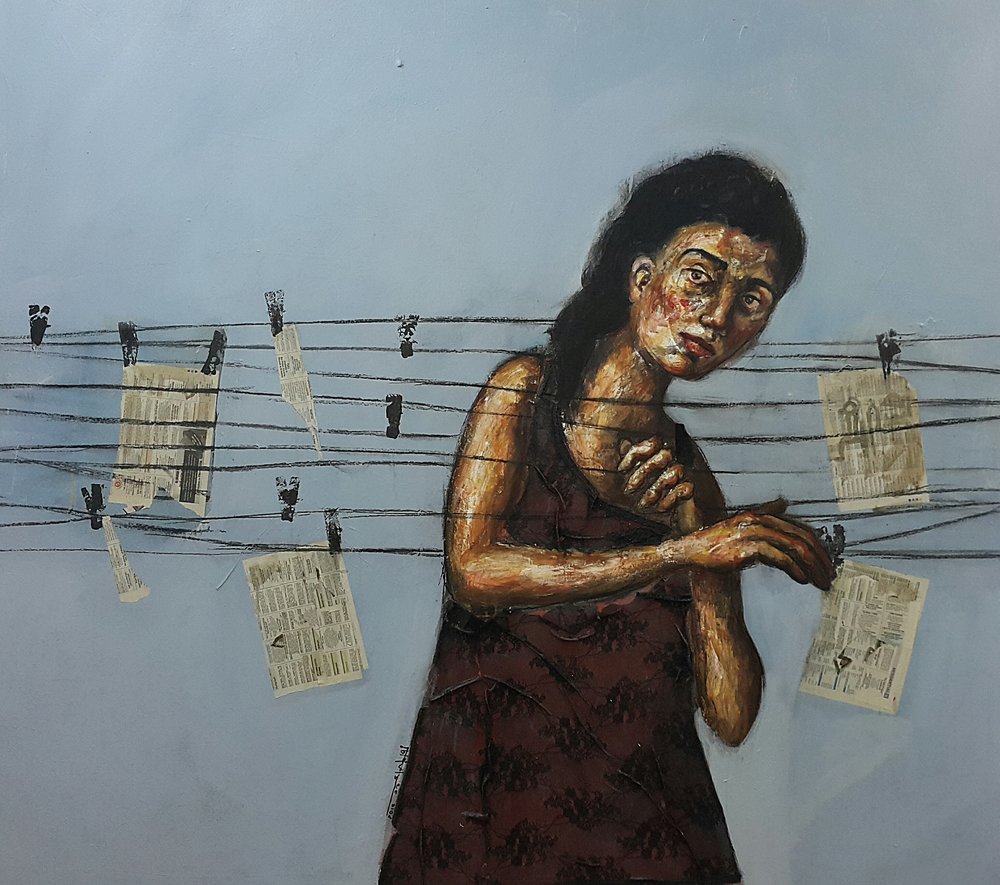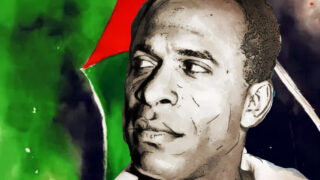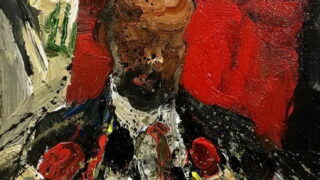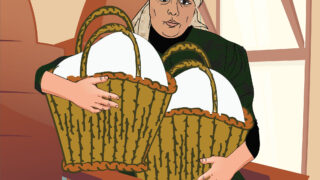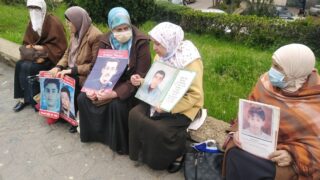
This publication has benefited from the support of the Rosa Luxemburg Foundation. This text may be reproduced in part or in full, provided the source is acknowledged.
It was in Egypt, more than 40 years ago, that I really understood the power of Djamila Bouhired, the icon of the Algerian revolution. It was enough that I introduce myself as an “Algerian” for my interlocutors to bow in respect: “Balad Djamila Bouhired” (“the country of Djamila Bouhired”), immediately followed by “Balad Alf wa millioun chahid” (“the country of more than one million martyrs”). It would take me much longer to realize the weight of this honor and its exceptionality.
The more this founding event - that is, the birth of the Algerian state and nation between the war of national liberation in November 1954 and gaining independence in July 1962- moves farther away in time, the more this woman-icon, who is installed at the center of our history “like an evidence” of it, moves farther away from this evidence, in turn.
Who would have imagined in the year 1954 that an Algerian woman would become the “ultimate” icon of this revolution; even “the icon of decolonization”, as the English historian Natalya Vince once put it? This event is all the more fascinating because it is exceptional; truly unparalleled in any other contemporary revolution, neither in Lenin's Russia, during the liberation of Vietnam Ho Chi Minh, in Fidel Castro’s and Che Guevara’s Latin America, nor in the European Resistance to Nazism, from Churchill to General De Gaulle.
The paradoxical aspect of the matter is accentuated by the fact that the status of Algerian women under colonization is hardly enviable. “If, in 1954, the Algerian population was 91% illiterate, (...) women pay an even bigger price than men, as no more than 4.5% of them were literate (1).”
Perhaps illiteracy can be measured, but how can one measure the tons of contempt that had once flooded “the Algerian woman”, this “Muslim”, “Arab” woman over a century and a half of colonization? Rarely has an image been so offended as hers, for the sake of proving a claimed Western superiority, portraying an Orient in which women and the harem mark the borderline between enlightenment and obscurantism.
For all these reasons, when the war of national liberation broke out, no one took Algerian women into account; neither the National Liberation Front (NLF), which forwent counting the women militants in its ranks (“we had decided not to count women", one of the leaders of the Federation of NLF in France writes in his memoirs (2), nor colonialism. When the names of the first arrested Moudjahidates appeared in the newspapers in 1955, they were thought to be Egyptians or, even, “communists” of European origin.
What a paradox between the prejudices that are built to render Algerian women invisible and the reality of one woman-icon who has made herself visible in the context of a historical, unprecedented event.
Rarely has an image been so offended as that of the Algerian woman, for the sake of proving a claimed Western superiority, portraying an Orient in which women and the harem mark the borderline between enlightenment and obscurantism.
It is also a lesson to be heeded when we intend to write: let us be wary of words which a priori confine Algerian women, “Muslim women”, inside the prison of obviousness and prejudices, rendering their resistance invisible and obscuring the historical, material and immaterial conditions in which they are revered or belittled.
The civilizational reading of the world thus imposes itself - between the image of the chained savage woman and that of the liberated modern woman - by the erasure of the significance of “indigenous women” in the systems of economic, ideological and cultural hegemony, and through the invisibility of the strategies that they had taken up in order to survive, before their own footprints could testify for their existence, proving that they, submissive or rebellious, are always active and influential.
In the same axiomatic context, we are repeatedly told that after independence, “Algerian women were sent home”, that is to say they were sent back to their families, as though they were “movable objects”, from colonialism to liberation, from war to the family, by the sole power of mere words which ignore that these transformations were part of the wide-scale changes which have turned the world upside down.
“When a man welcomes his wife who has spent two weeks in a French camp and he says hello to her and asks her if she is hungry, and he avoids looking at her and bows his head, when such things are a daily occurrence, it is not possible to imagine that the Algerian family can have remained intact and that hatred of colonialism has not swelled immeasurably,” writes Frantz Fanon (3).
Despite this Fanonian warning, this second image of Algerian women remains intact and is not questioned enough. As proof of this, we underline, for example, the fact that the number of women in the first National Assembly after independence was no more than five. And, so it was, but at the same time, how could we not recall that it is a woman deputy to whom we owe the passing of a 1963 law that bears her name: “The Khemisti Stefani law,” which specified the legal age for marriage at 18 for men and 16 for women; a revolution in “the Arab world” at the time. This change, which may seem miniscule, bears witness to the political resistances of women and will remain a milestone that proves beyond doubt the real place of women in society and shows what is changing “at home.”
No one took Algerian women into account; neither the NLF, which forwent counting the women militants in its ranks: “We had decided not to count women”, one of the leaders of the Federation wrote in his memoirs, nor colonialism. nor colonialism. When the names of the first arrested Moudjahidates appeared in the newspapers in 1955, they were thought to be Egyptians or “communists” of European origins.
“If in 1963, thousands of minors were married off by their families, in 1998 (...), only 3% of married women were aged 15 to 19, against almost 50% in 1966. The variations are striking: the percentage of unmarried women aged 20 to 24 is 7 times higher than in 1966, and that of women aged 25 to 29 is more than eleven times that in 1966” (4). This is spectacular indeed, especially that “for Muslims, marriage is a Sunnah.”
Between the woman-icon and the women “sent home”, the representations of Algerian women oscillate between glorification and contempt. In this inbetweenness, there is a void to fill, without yielding to the narratives told by the dominant parties who seek to propagate their ideological and material interests by giving women the role of the mute subordinate.
Do women have their own history? The novelty of this question often comes as a surprise, even in France, for example, where this question did not arise until the mid-1970s. It is by asking this particular question that feminist thought and history - as a discipline - have opened up doors to a new continent of knowledge which upsets many so-called certainties. In the course of this history which is being rewritten, do Muslim, Arab and Berber women also have a history of their own? Allowing ourselves the liberty to ask this question is all it takes for another narrative to appear and prevail, despite the shallowness of written records and archives about it.
The number of women in the first National Assembly after independence was five. However, how could we not recall that it is a woman deputy and one of the Moujahidates to whom we owe the passing of a 1963 law that bears her name: “The Khemisti Stefani law,” which specified the legal age for marriage at 18 for men and 16 for women; a revolution in “the Arab world” at the time.
When the “mujahedin” tell us their testimonies about Algerian women in the war, they say: “they helped”, and when you nudge them to try and remember more deeply, they suddenly become pensive, “they were very brave,” they would say, and then, as if surprised by their own words, they go completely silent. Silence. What does the story of Djamila Bouhired tell us? The story of this young girl from the Casbah who, barely 24 years old, working as an apprentice seamstress in 1957, finds herself carrying the weight of an icon? To question the history of Algerian women in the national liberation war is to question the history of silence because silence has a history of its own.
The silence and the icon
“I'm afraid my words are weak.” Thus apologized Djamila Bouhired in Beirut during a reception held in her honor in 2014. How can we not heed this explicit fear in the words spoken by this historic NLF activist, celebrated for her courage, unshaken by neither the torture she had endured nor the guillotine she had been promised by the military and colonial tribunal?
The image of an icon is an ambiguous one; it attests to birth and death, both. The mere mention of her name marks the birth of a nation and the death of one and a half million martyrs. The figure, although inflated, cannot be wiped out, because it tells the price of blood and the suffering of the Algerian people in their resistance to the colonial monstrosity. Can this weight be carried without fear that the words that describe it come out too “weak”? Is there a way to make them less feeble other than silence?
It is the silence of those who had died which inhabits her thoughts, and she does not hide it, as if the power of this iconic woman were doomed to remain walled in these confines, in fidelity to the memory of the deceased. How could one not be afraid of the failure of words for fear of betraying not the figure of the icon, but that of the ones who had sacrificed themselves? Being an icon does not absolve one of silence; on the contrary, it aggravates the silence.
The icon is also an ambiguous power: it can reveal and veil at once. it is a body – a medium that speaks without words. It informs and narrates a history: in Algeria and in the war of liberation and through the bodies of women, something extraordinary has happened. Women, from the “Maquis” to the “Fidaiis”, from the peasants to the city dwellers, from the students to the illiterate, from the nurses to the workers, and from Algeria to France, were doing the unthinkable and the unforgettable: waging war on colonial France. They did more than give “considerable help to the independence of their country”, as the historian Michèle Perrot; a reference in the history of women in France, has said (5). And they did not “have to assimilate into the national battle and support the men who carried it”, as the political scientist Khadija Mohsen-Finan has noted (6).
They did more than that; offering their own intimate experience of what colonialism is, as the “indigenous of the indigenous”, and it was their hatred for the occupation which had empowered them with this incredible strength to break out of their imprisonment, family, guardians and numerous taboos. They wore the clothes of war; a field which is usually reserved for men, and not only did they partake in combat, but soon their presence became visible in the newspapers, maquis (guerillas), courts, prisons and even in the torture chambers.
“The Battle of Algiers” sent the film “Djamila,” by director Youcef Chahine, into oblivion. The latter had been made in a hurry in 1958 to mobilize public opinion against the imminent execution of Djamila Bouhired, as part of a global campaign which saw the uprising of all anti-colonials in the world. Ho Chi Minh was committed to the campaign, while Fairouz, Warda el Djazairiya, and Egyptian singer Sou'ad Mohamed, all sang for her, while Jacques Vergès, Bouhired’s lawyer who later became her husband, together with Georges Arnaud published the book “For Djamila Bouhired.”
The film documents the art of writing dominant narratives that transform the female actors in history into women-objects, stripped of every quality, and even of their names. It illustrates how the invisibility of women in history is a construct that produces and reproduces the power of the dominant.
In this regard, the revolutionary Djamila Bouhired is a perfect example of both the fabulousness of the legend and the monstrosity of the war. She is a “bomb placer” and one of those who shifted the geographies of violence away from “the Arab city” which was surrounded by paratroopers, and into “the white city,” during the time of the “black feet’s” (French settlers) pre-dinner drinks. She knew the Casbah just as much as any man, but much better than the police.
Bouhired was shot and wounded as she and the military leaders of the “autonomous zone” of Algiers were fleeing the terrible crackdown of 1957, and she was carrying numerous confidential documents. She went from the hospital to the torture room, then to the military court which condemned her to death by the guillotine, while the colonialists demanded her lynching. In addition to all this, she was as beautiful as day. This is, indeed, a huge load for one woman; a “sister” among “brothers,” to carry.
Between the woman-icon and the women “sent home”, the representations of Algerian women oscillate between glorification and contempt. In this inbetweenness, there is a void to fill, without yielding to the narratives told by the dominant parties who seek to propagate their ideological and material interests by giving women the role of the mute subordinate.
It was not until 1990, with the publication of the book “Algerian Women in War” in Algeria, written originally as a university thesis by the moujahida-turned-historian, Danièle Djamila Amrane-Minne, that women finally broke the silence of history. In his preface for the book, André Mandouze, the pro-NLF French historian, writes: “(...) We have accepted the praising of the brilliant actions of a few women or their exceptional vocations, yet it does not seem like we are aware, or perhaps we have pretended not to be aware, of the fact that these individual actions presupposed an intricate backdrop woven by the growing crowd of Algerian women who, in their own way, “formed one front” (...) (7)”. Was it a front within the front and a revolution within the revolution?
But in the words of the feminist sociologist Christine Delphy, “the oppressed are only tolerable when they know how to be discreet.” “The brothers” defended themselves in the face of what they considered a threat to the source of their power, and hence, they took over the power of words and rewrote the story of the war in a way which is convenient to them, returning the world to its previous state, reminding everyone that the “icon” had a “leader”; the leader of the “autonomous zone,” Yacef Saadi (1957).
And, lest anyone forgets this, Saadi became a producer and an actor who portrayed his own story after independence. He, himself, chose Gillo Pontecorvo to direct the film, “The Battle of Algiers;” a film so influential that it would become a cult classic, regarded as an archival documentation of reality by the official history of Algeria. Likewise, French historian and renown expert in anti-colonial battles, Benjamin Stora, bestows a “documentary value” on the film. So be it, but what does the film document from the perspective of Algerian women?
From icon to nameless woman
First, it has ushered the film “Djamila,” by director Youcef Chahine, into oblivion. The film had been made in a hurry in 1958 to mobilize public opinion against the imminent execution of Djamila Bouhired, as part of a global campaign which saw the uprising of all anti-colonials in the world. Ho Chi Minh was committed to said campaign, while Fairouz, Warda el Djazairiya, and Egyptian singer Sou'ad Mohamed, all sang for her. Jacques Vergès, Bouhired’s lawyer who later became her husband, together with Georges Arnaud published the book “For Djamila Bouhired” in 1957 (published by Editions de Minuit, Paris).
All of those men and women “celebrated her exploits and her sufferings. This is a unique case, as no other film and no other song (…) during the war was known to have been devoted to one person as such.”
While in Youcef Chahine’s film, “Djamila” is seen standing on a platform, drawing up maps and plans that would guide the women “bombers”, “The Battle of Algiers” portrays her standing in line, silent, as she waits for Yacef Saadi to hand her a pouch containing a bomb. The “fida’iya” (woman resistance fighter) is, hence, no more than an instrument of the military genius “of the male leader.”
In 2013, Saadi remembers his role as a producer on the film during an interview with Ennahar TV in Algeria: “We brought in the girls,” (he says about casting the actresses who would play the parts of the women fida’is on the screen, Editor's note), “and we chose a girl for the part of Djamila Bouhired, and another one for another’s part…No need to mention their names, because when I talk about this or that bomb and the places they were planted, people already know who was behind planting them there.”
In “The Battle of Algiers”, the names of Djamila Bouhired, Zohra Drif and Samia Lakhdari, the first three resistance fighters who had detonated the earliest bombs of the real battle of Algiers, have disappeared from the narrative. And since “people know,” we can help them forget by replacing these women’s names with the names of the ruins of their targets: “the Cafeteria, the Milk Bar and the Mauretania.” Replace names with things. It is an archive of the masculine imagination when it feels threatened.
What a great feat. Through the magic of his cinema, the names of Djamila Bouhired, Zohra Drif and Samia Lakhdari, the first three resistance fighters who had detonated the earliest bombs of the real battle of Algiers, have disappeared from the narrative. And since “people know,” we can help them forget by replacing these women’s names with the names of the ruins of their targets: “the Cafeteria, the Milk Bar and the Mauretania.” Replace names with things. What a documentation of the constructed erasure of “the girls.”
“The Battle of Algiers”, written by an Algerian nationalist and an Italian communist, is in truth an archive of the masculine imagination when it feels threatened. It places men at the center of the war and insists that women are only present at the periphery. Paratroopers, moudjahidin, or otherwise, men fight “man to man,” although with disproportionate weapons. The film magnifies the majesty of the bodies of men, as Yacef Saadi and Ali La Pointe, “the bad boy” on whom the revolution has bestowed the beauty of the Gods, stand against Bigeard and Massu in their tight leopard paratrooper outfits and their movie star dark sunglasses.
As such, “The Battle of Algiers” documents the art of writing dominant narratives that transform the female actors in history into women-objects, stripped of every quality, and even of their names. It illustrates how the invisibility of women in history is a construct that produces and reproduces the power of the dominant. Is there, then, any “truth” but the truth of the “leader”? We have a right to doubt, for is not doubt the first step to freedom? Let us be wary of words, of these representations taken out of contexts, which imprison women in “the fixed obvious” without a way out, or in the “mektoub” (destiny), which erases resistances and subversions, predicting nothing but a future of submissiveness, and magnifying it in such a way that it eclipses all else.
The content of this publication is the sole responsibility of Assafir Al-Arabi and Rosa Luxemburg Foundation cannot accept any liability for it.
Translated from French by Sabah Jalloul
Published in Assafir Al-Arabi on 21/12/2021
1) Danièle Djamila Amrane-Minne, “Algerian women in war”, preface by A. Mandouze. Ed. Barzakh, Algiers, 2014, p.37.
2) Ali Haroun, “The seventh Wilaya, The war of NLF in France” (“La 7ieme wilaya, la guerre du FLN en France 1954-1962”), Ed. Seuil, 1986.
3) Frantz Fanon, “The Fifth year of the Algerian revolution”, Maspéro, 1959.
4) “To be thirty years old and still be single: an emerging category in Algeria,” by Zahia Ouadah-Bedidi), in: Autrepart.
5) Danièle Djamila Amrane-Minne, “Women in war”, preface by Michèle Perrot, Ed. Dif, 2004.
6) The image of women in the Maghreb, edited by K. Mohsen-Finan, Ed. Acte Sud / Barzakh.
7) Danièle Djamila Amrane-Minne, “Algerian women in war”, Op. Cit. P. 23.

